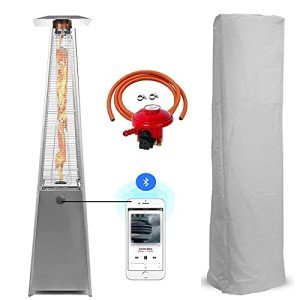Why Do So Many People Would Like To Learn More About Patio Heating?

Buying Gas Radiant Heaters: A Comprehensive Guide
Gas radiant heaters have actually acquired appeal in recent years for their efficiency and capability to supply immediate warmth. As more house owners and businesses look for methods to keep their areas comfy, understanding the functions, advantages, and considerations when buying these heating units can be very useful. This article digs into the intricacies of gas radiant heaters, aiding potential buyers in making informed choices.
What are Gas Radiant Heaters?
Gas radiant heaters are gadgets that utilize propane or natural gas to discharge heat directly into a space. Instead of heating the air, they warm objects and people in their vicinity, supplying comfort faster and effectively. These heaters are popular for both indoor and outdoor settings due to their flexibility and effectiveness.
Secret Features of Gas Radiant Heaters
- Direct Heating: Unlike standard heaters that warm the air, gas radiant heaters supply direct warmth, making them an efficient option for rapidly warming up spaces.
- Mobility: Many designs are readily available as portable systems, permitting them to be quickly moved from one area to another.
- Fuel Variety: Gas radiant heaters can be powered by natural gas or propane, offering users flexibility based on schedule and preference.
- Adjustable Settings: Most gas radiant heaters included adjustable heat settings, allowing users to tailor the level of warmth based on their requirements.
Advantages of Gas Radiant Heaters
- Energy Efficiency: These heaters convert gas into heat effectively, leading to lower utility bills compared to electric heaters.
- Quick Heating: Radiant heat is felt nearly instantly, making these heaters suitable for abrupt temperature drops.
- Low Maintenance: Gas radiant heaters normally need less upkeep than electric designs, making them a hassle-free option.
- Environmentally Friendly: When powered by tidy natural gas, these heaters can be a more environmentally sustainable choice compared to other heating approaches.
Types of Gas Radiant Heaters
When it comes to selecting a gas radiant heater, it's important to understand the various types available. Below are the most typical options:
- Indoor Gas Radiant Heaters: Designed for indoor areas, these heaters are typically vented or unvented and often included built-in safety features.
- Outdoor Gas Radiant Heaters: Commonly used in patio areas or outdoor dining areas, these heaters are designed to hold up against the elements.
- Wall-Mounted Gas Radiant Heaters: A space-saving alternative, these systems are perfect for smaller spaces and can be outfitted with various heat outputs depending on the location's requirements.
- Freestanding Gas Radiant Heaters: These portable designs can be used in different places, ideal for those who need versatility.
Buying Guide: How to Choose the Right Gas Radiant Heater
When acquiring a gas radiant heater, several elements must be considered to guarantee you choose the best model for your space:
1. Heating Capacity
- Determined in BTUs (British Thermal Units), the heater's capacity determines how much area it can effectively warm. Purchasers must assess their particular requirements based upon room size.
| Space Size (sq ft) | Recommended BTUs (for Gas Radiant Heaters) |
|---|---|
| 100 - 200 | 5,000 - 10,000 BTUs |
| 200 - 400 | 10,000 - 20,000 BTUs |
| 400 - 600 | 20,000 - 30,000 BTUs |
| 600 - 800 | 30,000+ BTUs |
2. Kind of Gas
- Consider whether you will be using propane or natural gas, as various heaters cater to various fuel types.
3. Security Features
- Try to find models geared up with safety functions such as automatic shut-off valves, tip-over protection, and oxygen exhaustion sensors.
4. Installation Requirements
- Some heaters may require professional setup, specifically vented designs. Make sure to think about the costs and requirements associated with setup.
5. Portability
- If flexibility is important, think about portable designs that can be quickly moved from one area to another.
Setup and Maintenance
Gas radiant heaters are typically straightforward to set up, especially portable designs. Nevertheless, vented options might require expert setup to guarantee they meet local safety codes.
Maintenance generally includes:
- Regular cleansing to avoid dust accumulation.
- Examining gas connections and fittings for leaks.
- Making sure safety functions are practical.
Idea: Regular checks around the unit can help extend its life expectancy and keep safety.
Frequently Asked Questions (FAQs)
Q1: Are gas radiant heaters safe for indoor use?A1: Yes
, as long as they are properly vented and equipped with essential security features, they can be securely used inside.
Q2: Can gas radiant heaters be utilized in enclosed spaces?A2: Unvented gas heaters can present threats in enclosed spaces due to potential suffocation or carbon monoxide buildup. Constantly guarantee enough ventilation. Q3: How do I understand what size heater I need?A3: The proper size depends on the location you intend to heat. Refer to the BTU chart
above to identify your needs. Q4: What is the distinction in between propane and natural gas heaters?A4: The main distinction lies in their energy source
; propane is provided via tanks, while natural gas is typically piped into homes. Buy Gas Patio Heaters Uk : How can I maximize efficiency?A5: Ensure the heater is appropriately sized for your space, keep it regularly, and consider utilizing it in combination
with other heating techniques for optimum convenience. Gas radiant heaters can be a great addition to any home or organization, offering energy-efficient and fast heating solutions. By comprehending the different types, features, and factors to consider
when buying, buyers can make educated decisions that meet their heating needs. With the ideal option, these heaters offer convenience, reliability, and a welcoming environment during cooler seasons.

